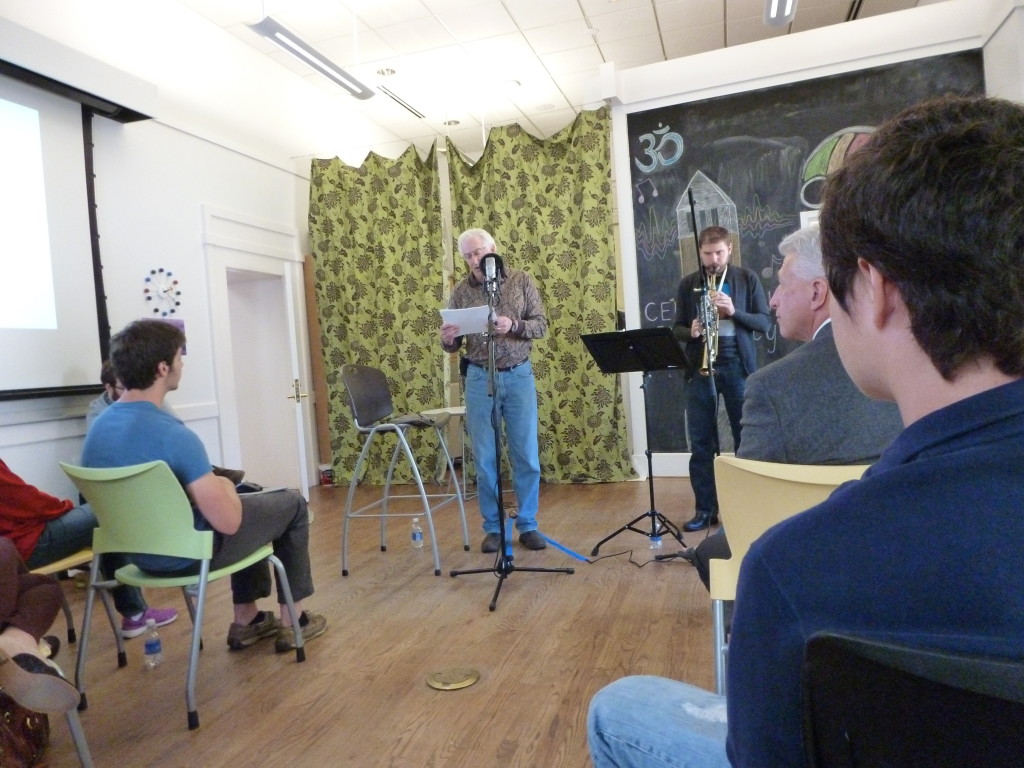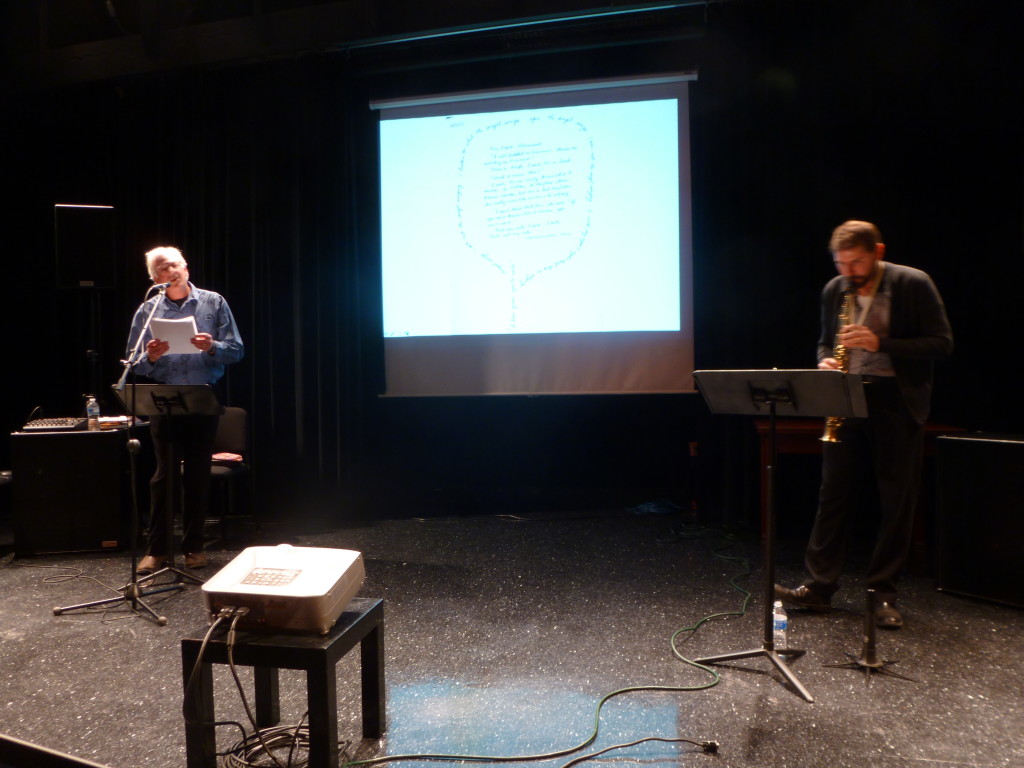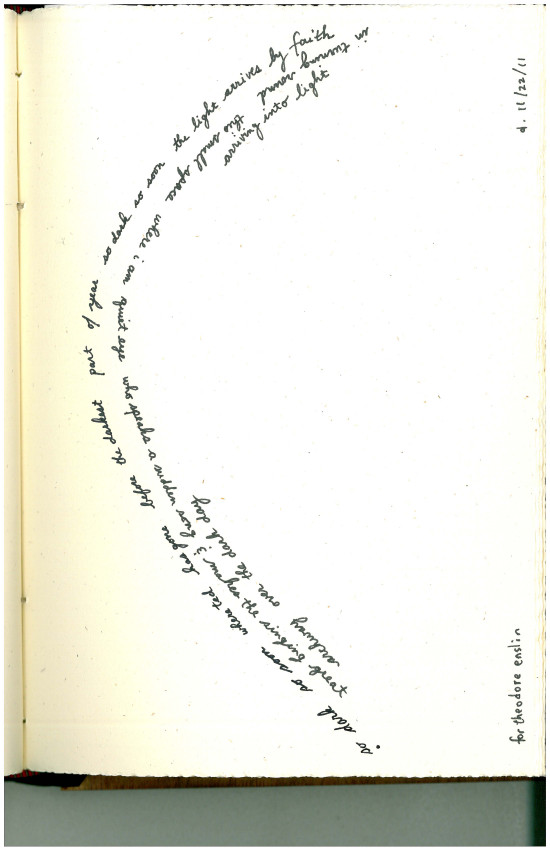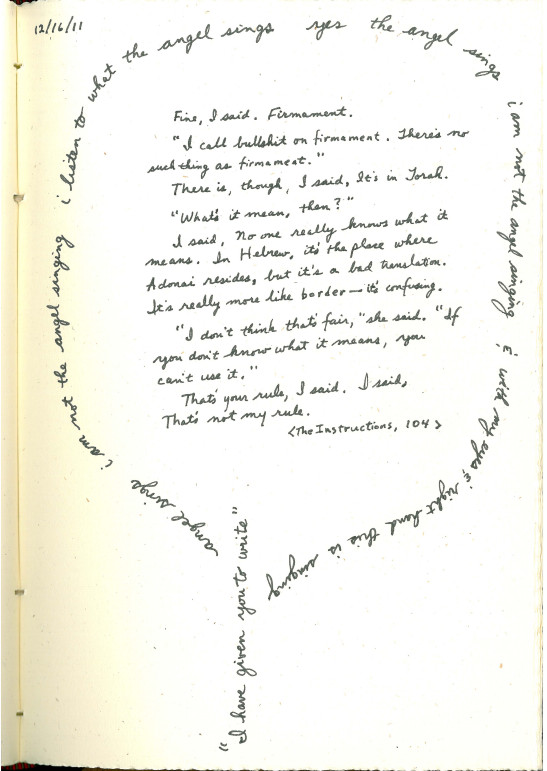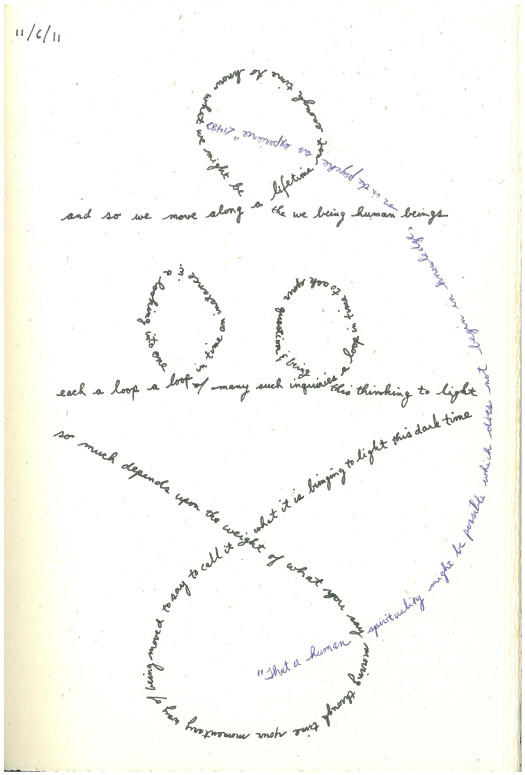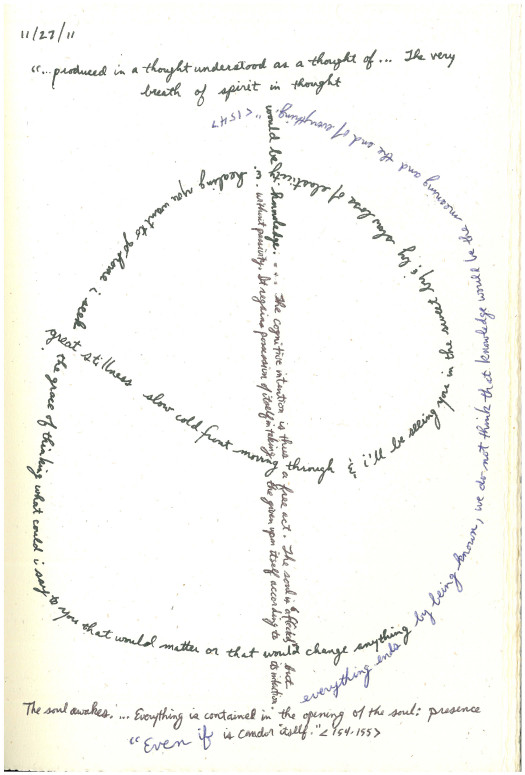The poet with Andrew Raffo Dewar on soprano saxophone, rehearsing at Maxwell Hall, University of Alabama, November 2013
“TALK SHOW: A Conversation between Glenn Mott and Hank Lazer”
GM: For most writers handwriting is a matter of composition, a choice not to use a keyboard. Seeing a writer’s script, one who you’ve read only in type can be a revelation, a new discovery of their work, as in published diaries or journals, or a surprise at the power of print versus the intimacy of the hand. I felt this when I first saw Emily Dickinson’s poems in pencil on envelope backs and scraps of paper. What is it about handwriting a poem, and publishing it without setting it to type that feels special, and what does that do to the reading experience?
I’m at a digital journalism conference as I ask this, so I can’t help but wonder how this all fits in with technology. I’ve seen depressing demonstrations of algorithms that write the sporting news, and print referred to as legacy media. But we have yet to master an instrument robotically sensitive or as neurally complicated as the human hand.
HL: Please know that whatever answer I provide, it’s taken me several years to develop this sense: Among other things, the handwritten turns out to be a way to defamiliarize, slow down, and make more intimate that reading experience of the page, pages, or book. For some (many?) of these handwritten pages, it is not at all clear where to begin the reading. Indeed, there are multiple options. Even when the beginning seems clear, usually the reader will need to rotate the page/screen several times to follow the contour of the poem. (I’ve had reports from poet-friends who were reading N18 (complete) in a public space and had people stare at this odd action of rotating the page in order to read.) And, as you suggest, the work of the hand, the specificity of a particular hand (and person) doing the writing is totally different than the effects of type.
(Click the player later in the interview, above Susan Bee’s painting, to hear a jazz-and-poetry improvisation based on this notebook page).
Oddly, and rather surprisingly to me, with the notebook pages I very quickly become the reader of the pages and experience my writing activity (now in the past) as that of a portal or doorway through which the poems occur. As the substantial amount of quotation indicates, these pages are not all “my” voice. They are a site for what I’ve called vectored thinking—different contending thoughts, phrases, perspectives that, as in a mobile, have a weight and force suspended on the page.
By virtue of the shape of the writing—what I’ve been calling shape-writing—there is a pronounced visual element that, at times, seems to supplant the location of the traditionally “poetic” (i.e. the elegance or craft of the words and phrasing). It may be that the shape-writing actually occludes or occults the “poetry.” Perhaps a reasonable question would be, “and why would you, why would anyone, want to do that now,” particularly at a time when poetry itself is (allegedly) so marginalized and barely has a commodity-pulse.
GM: There’s a stray association I make when you when you say shape-writing. I immediately think of sacred heart singers and shape-note hymns. Something homemade and accessible. This folk art also has its origins in the American South, where you live and work, and there are times when I really think a lot of these tendencies originated not in “poetry” (as you prefer to quote it) but reflects your development as a poet, seeing things like hand painted sign boards and the outsider constructions of hell-fire road-siders, self-proclaimed prophets of the Christian apocalypse knocking stuff together in their front yards along the kudzu byways.
Your intellectual arc is within a tradition of modern Western discovery, one that retraces a path to the primitive in search of the sacred—and reminds me of what John Cage does with early American anthems and congregational music in “Thirteen Harmonies.”
I see today that the composer John Taverner has died. He spoke of having a crisis of composition in the insight that the liturgical music he was composing had lost touch with the tradition of sacred tonal music, realizing the sacred had been pushed out gradually by the domination of the ego. So he turned to music of Persia, India, and Native Americans.
HL: Well, you know me too well, and you know the South well. You’re exactly right about the homemade or outsider or folk nature of the handwritten and its links to Southern vernacular art forms. You had typed “sacred heart singing,” which, at first, I corrected to “sacred harp singing,” but, as usual, we can often learn more from a so-called error.
GM: Ah, it’s true . . . there’s still some Catholicism of the Sacred Heart catechism knocking around in me as a boy . . .
HL: Of course such singing and vernacular art forms generally are close to the heart, and, in my opinion, sacred as well. I actually once did take part in a sacred harp meeting. (I’m a god-awful singer…) My instructor was one of the janitors from the aquatic center, and he was rumored to be a neo-Nazi. We got along well, and he taught me a good bit about shape-note-singing. From the very beginning of my life in Alabama (1977), I have been drawn to the world of folk art / outsider art, much of which is Christian visionary in nature. And from the very beginning of my days here in Alabama, I have had a strong sense of a close linkage between innovative poetry (which is usually branded as elitist or esoteric or out of touch with “the people”) and self-taught outsider art. So, yes, and proudly, my handwritten notebooks are participatory in a Southern cultural domain.
GM: I’ll just disagree that what you’re doing occludes or occults the poetry, except that you are avoiding the “P” term as meaning something left-justified on a typeset page that doesn’t obstruct the dinkiness of clever word play. But yes, to embrace innovative practices to defamiliarize, as you say.
What shape-writing does most effectively is manage the element of time in composition. We see your choices, sometimes turn-for-turn on the page, “the light arrives by faith / in turning round,” this is both faith in a sunrise and the physical reversal of the direction of the line. The turn, or arc of a word, affects your outcome and I see pauses, pivots, and hesitation before your willingness to go on, like Beckett, streaming, then shaping. There used to be a coffee shop in Beijing when I lived there called Sculpting In Time. I think I’ll throw that in here as an apt description of this process. Shape-writing, like concrete poetry, is also a formal practice, replacing representational images with slithering interconnected lines. These lines give you new forms for composition, while slowing down the reading to a liminal state of being in-between. Transitions, choices, unintentional missteps are being made by the reader, and they affect the outcome. It’s playful, but can be a slog without the right mindfulness (that word of the moment). I suppose it’s the reason some editors have a hard time accepting these for publication. It’s not a matter of being unable to print handwritten poems. They will want a transcription of the “correct” reading, to narrow the attention span. Is that a fair appraisal of what you’ve told me? And what’s been the reception?
HL: I love your remarks on the element of time in the composition of the notebook pages/poems. After all, the initial big name for this project was The Notebooks (of Being & Time), linked to my reading of Heidegger’s Being and Time. Sculpting In Time is a perfect name for this activity. The notebook pages deliberately make manifest the time of composition, and the imperfection and performance of that momentary engagement with language.
The reception has been pretty good. A number of magazines—in print and online—have featured work from the notebooks. There have also been a number of very thoughtful reviews, particularly by Nathan Hauke (Drunken Boat) and Jake Marmer (Jewish Daily Forward)—naming N18 one of its five “favorite poetry books of 2012”).
On the occluding or occulting of the poetry in the shape-written pages, I don’t mean to suggest that the writing is not poetic. It is, and I’ve not really retreated from the lyricism that I love. All I mean to say is that the foregrounding of shape itself perhaps constitutes an initial (momentary) shading or re-direction of attention from the more customary engagement with the sound of words.
GM: Want to know something strange? I just looked at Susan Bee’s painting for the cover of this suite for the first time, and there’s that harp.
(Click the player below to hear Hank Lazer and Andrew Raffo Dewar perform a jazz-poetry improvisation related to Susan Bee’s painting and the Notebook page 12/16/11 “angel sings”.)
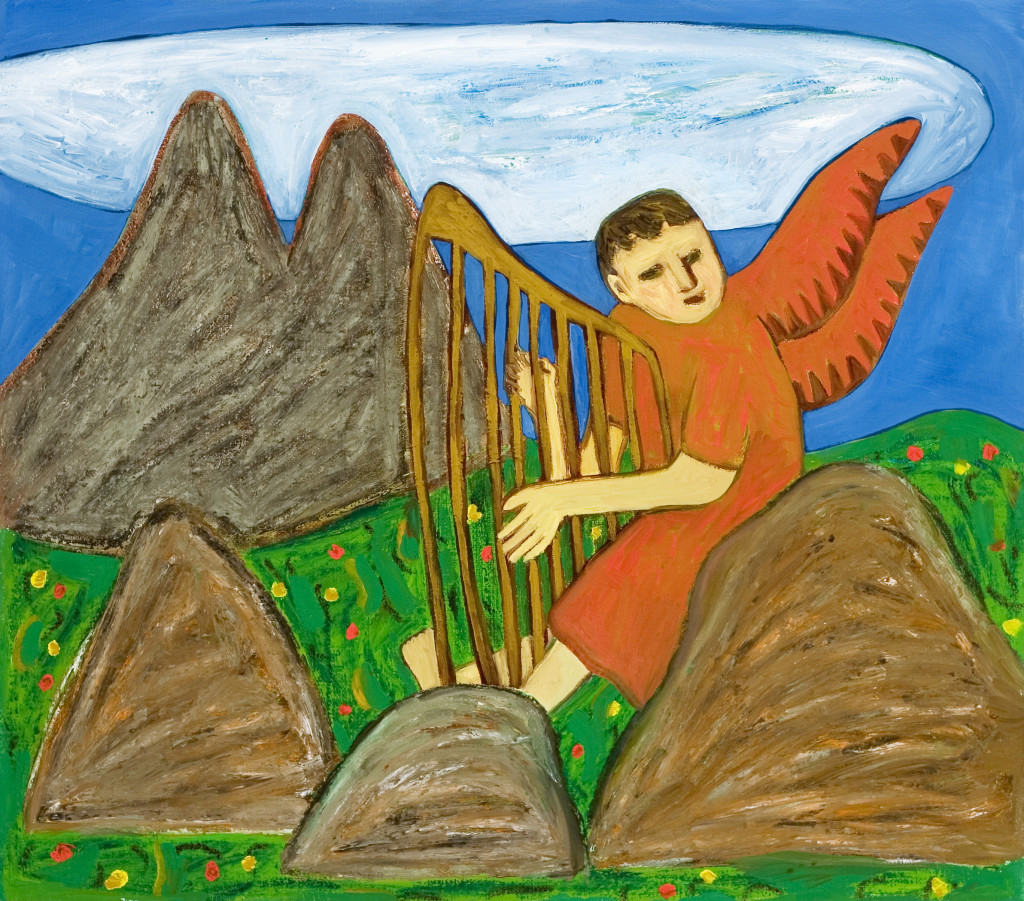
Tell me about the collaborative readings involved here.
HL: Collaborative readings is one way to put it. One might alternatively say collage or vectored thinking or ventriloquism or other voices (as in the end of George Oppen’s superb late poem “Till Other Voices Wake Us” where he rewrites the ending of Eliot’s “Prufrock,” changing it from: “Till human voices wake us, and we drown” to “till other voices wake/ us or we drown”). The readings I do in philosophy while writing the notebooks occupy an adjacent space. I’m not trying to analyze or interpret or even clarify these writings. In one sense, I’m hunting for interesting sentences – which might influence, or push back upon my writing, or serve as a stimulus. Of course, I’ve been picking books and writers who have been thinking deeply about the fundamental terms that are of importance to the notebooks: spirit, being, time, perception, consciousness, language. One might think of each notebook page as a kind of Calder-like mobile, where the various phrases, quotations, and new writing all have a force or weight that creates a somewhat stable (though moveable) existence for the duration of that one page. The absolute otherness of the quoted material—in the Plume series of pages, from Emanuel Levinas’ Of God Who Comes to Mind—makes me more immediately a portal or doorway or medium (or scribe) for the pages, and I also more immediately become their reader (rather than their writer). It also helps me to understand the passages better by the careful act of writing them longhand and by finding out their shape in the time of writing.
I realized recently that I’ve been doing what you’ve referred to as “collaborative reading” ever since the “Law-Poems” series written in the mid-1980s; these poems incorporated verbatim sections of the Alabama Legal Code. Subsequently, H’s Journal quotes from Thoreau’s Journal. My book Days includes quotations and marginalia. In some fundamental way, collaborative reading must stem from my strong sense that reading and writing are so closely related as to have no meaningful boundary, and the same holds true for “critical writing” and “creative writing,” terms that have institutional boundaries, but in practice, are meaningless segregations.
And as I re-read my responses, Glenn, I realize that actually the beginning of my collaborative reading/writing goes back much earlier, to “The Cricket’s Chant,” my 1973 M.A. thesis at Virginia, that consisted entirely of lineated poems constructed from passages in Thoreau’s Journal.
GM: I notice many instances of recurring words and themes in the Notebooks. The words: spirit, faith, song, consciousness, knowledge, mentions of Torah, and a concern for the brevity of time, the uncertainty of firmament. This reminds me of the break that your book The New Spirit made with a certain fundamentalist strain of innovators in poetry. What’s going on?
HL: As for “spirit,” as you know, it’s a term that I’ve been writing in, through, about, on, and around for the past twenty years, including the essays in Lyric & Spirit. The poems (and essays) say what I know or have experienced of spirit. It’s an admittedly vague term, but one that I find productive and generative and provocative in its exact vagueness. Perhaps “spirit” is another word for the (tangible) invisible, as in Merleau-Ponty’s wonderful book The Visible and the Invisible. Just as I make a distinction between religious and religion, “spirit,” as I think of it, has nothing to do with institutional affiliation nor fixed doctrine or definition. It is a term that opens up to considerations of the nature of consciousness, of language and its relationship to being (and to a possible telos of language), to thinking, to music, to a beyond, to worlds beyond our five senses. Mostly, though, I’ve been concerned (in my essays, and in my poetry, most especially the notebooks) with what I think of as a phenomenology of spiritual experience (i.e., a recording of an ongoing relationship to the invisible), with an insistence on noting as well its radical inconstancy, its intermittent and often momentary nature.
GM: So we’re gonna die. And that cat’s eye of October 29, 2011 in this suite of notebook pages provides a kind of answer? “ . . . that knowledge of the world is a satisfaction, as though this knowledge filled a need?” If you were to state it simply, where does the writing and reading of poetry come into the equation?
HL: Not an answer, but a moment of conversation, of engagement in and through and of this world. (Reminds me of one of my favorite Jewish jokes: Q: Why does a Jew always answer a question with another question? A: I don’t know; why?) And of the two Levinas quotes, the left-hand arc is, of course, a question. Perhaps for me, knowledge of the world is questionable, or filled with questioning, or questioning is at the heart of that questing? Your question and emphasis on the right-hand arc of the page make me think of Rilke, particular in the Duino Elegies, where the act of poetry and of naming itself is suggested as a needed means of completing the very nature of the world (and of being). In other words, one of poetry’s most sacred functions is to provide a space for consciousness of the world, a place for what I’ve called “thinking singing.” The poem represents a kind of fulfillment of being by singing its praise and by naming it in all its complexity or by singing its ungraspable though lovely nature. Or, perhaps in answer to Heidegger’s question, What calls for thinking? poetry makes manifest a way of responding and reflecting, or putting into play and shape in language an engagement with that question.
Of course, the arc of this so-called knowledge goes outward—toward the world and an expressing or kindred being—but also inward as well. The need and satisfaction (always temporary, I think, or at least such has been my experience of it) are also absolutely essential to our human existence. To use the language of Arakawa and Gins, this knowledge is part and parcel of our nature as enigma beings—as creatures whose nature, telos, and possibilities are always in question. Ours is a being that provokes questions, right?
GM: Reminds me of the Irish joke where Pat says to Mike, “Why are you digging a hole?” and Mike says, “I’m not digging a hole. I’m digging the dirt. And leaving a hole.”
Or, by doing what Oppen did to “Prufrock,” the revision this implies to me, in the first arc of your Levinas quote is: all that occurs in the human psyche, and all that takes place there, ends by being known.
Is that falsehood the necessary fiction of your poetry?
HL: Fiction? How could poetry not be a place where all is (possibly) known, providing that what we mean by known is perpetually incomplete and subject to additional writing (and con-versing)?
GM: Yes, a fiction revealed in the tortured logic of poetry. It’s all in there, Hank, and it’s a conundrum taking us back to your example of the Duino Elegies: Rilke’s terror at being annihilated by existence, unless what is known is also what is meant by being. Questioning, misreading, unfolding, or to essay, the root of which, coup d’essai, means to try. And this goes back to the inquiry of Lucretius “On the Nature of the Universe.” This is the nature of an ongoing conversation in poetry.
Poetry never completes. It opens.
And so, maybe it would be appropriate to end with Levinas, from his Entre Nous: “Thought at its beginning finds itself before the miracle of fact.”
Any closing thoughts?
HL: Your concluding riff puts me in mind of Robert Frost’s line, “The fact is the sweetest dream that labor knows.” I hope that the notebook pages/poems till that field, bringing up from the ground words and phrases and music that have the enigmatic obdurate nature of fact. May the pages be a simple, clear appearance that invites one to dwell there a while, to experience the shape, music, and multi-directional thinking that counts for a factual pointing toward.
GM: Arrowing, then, we will go.
Hank Lazer has published seventeen books of poetry, including Portions (Lavender Ink, 2009), The New Spirit(Singing Horse, 2005), Elegies & Vacations (Salt, 2004), and Days (Lavender Ink, 2002). Lazer’s seventeenth book of poetry N18 (complete), a handwritten book, is available from Singing Horse Press:http://singinghorsepress.com/titles/n18/ . Pages from the notebooks have been performed with soprano saxophonist Andrew Raffo Dewar. In 2008, Lyric & Spirit: Selected Essays, 1996-2008 was published by Omnidawn. Audio and video recordings of Lazer’s poetry and an interview for Art International Radio can be found at Lazer’s PennSound website: http://writing.upenn.edu/pennsound/x/Lazer.html.
Glenn Mott is managing editor of the Hearst newspaper syndicate, he has been a Fulbright Scholar at Tsinghua University in Beijing, and is author of the book Analects on a Chinese Screen. His reporting, poetry and translations have appeared in newspapers and periodicals in the United States and abroad, including Poetiche, The Miami Herald, The Atlantic, The Missouri Review, and Nieman Reports.

